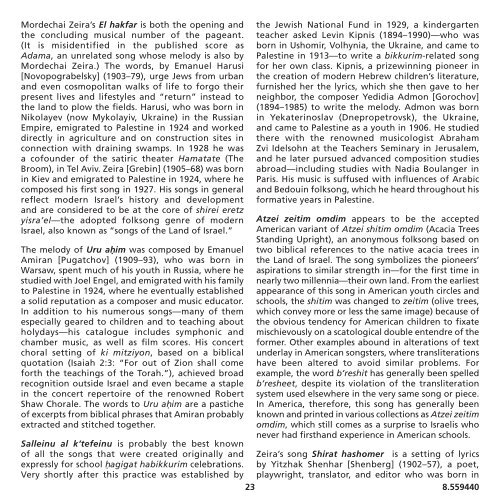Download Liner Notes PDF - Milken Archive of Jewish Music
Download Liner Notes PDF - Milken Archive of Jewish Music
Download Liner Notes PDF - Milken Archive of Jewish Music
Create successful ePaper yourself
Turn your PDF publications into a flip-book with our unique Google optimized e-Paper software.
Mordechai Zeira’s El hakfar is both the opening and<br />
the concluding musical number <strong>of</strong> the pageant.<br />
(It is misidentified in the published score as<br />
Adama, an unrelated song whose melody is also by<br />
Mordechai Zeira.) The words, by Emanuel Harusi<br />
[Novopograbelsky] (1903–79), urge Jews from urban<br />
and even cosmopolitan walks <strong>of</strong> life to forgo their<br />
present lives and lifestyles and “return” instead to<br />
the land to plow the fields. Harusi, who was born in<br />
Nikolayev (now Mykolayiv, Ukraine) in the Russian<br />
Empire, emigrated to Palestine in 1924 and worked<br />
directly in agriculture and on construction sites in<br />
connection with draining swamps. In 1928 he was<br />
a c<strong>of</strong>ounder <strong>of</strong> the satiric theater Hamatate (The<br />
Broom), in Tel Aviv. Zeira [Grebin] (1905–68) was born<br />
in Kiev and emigrated to Palestine in 1924, where he<br />
composed his first song in 1927. His songs in general<br />
reflect modern Israel’s history and development<br />
and are considered to be at the core <strong>of</strong> shirei eretz<br />
yisra’el—the adopted folksong genre <strong>of</strong> modern<br />
Israel, also known as “songs <strong>of</strong> the Land <strong>of</strong> Israel.”<br />
The melody <strong>of</strong> Uru aḥim was composed by Emanuel<br />
Amiran [Pugatchov] (1909–93), who was born in<br />
Warsaw, spent much <strong>of</strong> his youth in Russia, where he<br />
studied with Joel Engel, and emigrated with his family<br />
to Palestine in 1924, where he eventually established<br />
a solid reputation as a composer and music educator.<br />
In addition to his numerous songs—many <strong>of</strong> them<br />
especially geared to children and to teaching about<br />
holydays—his catalogue includes symphonic and<br />
chamber music, as well as film scores. His concert<br />
choral setting <strong>of</strong> ki mitziyon, based on a biblical<br />
quotation (Isaiah 2:3: “For out <strong>of</strong> Zion shall come<br />
forth the teachings <strong>of</strong> the Torah.”), achieved broad<br />
recognition outside Israel and even became a staple<br />
in the concert repertoire <strong>of</strong> the renowned Robert<br />
Shaw Chorale. The words to Uru aḥim are a pastiche<br />
<strong>of</strong> excerpts from biblical phrases that Amiran probably<br />
extracted and stitched together.<br />
Salleinu al k’tefeinu is probably the best known<br />
<strong>of</strong> all the songs that were created originally and<br />
expressly for school ḥagigat habikkurim celebrations.<br />
Very shortly after this practice was established by<br />
the <strong>Jewish</strong> National Fund in 1929, a kindergarten<br />
teacher asked Levin Kipnis (1894–1990)—who was<br />
born in Ushomir, Volhynia, the Ukraine, and came to<br />
Palestine in 1913—to write a bikkurim-related song<br />
for her own class. Kipnis, a prizewinning pioneer in<br />
the creation <strong>of</strong> modern Hebrew children’s literature,<br />
furnished her the lyrics, which she then gave to her<br />
neighbor, the composer Yedidia Admon [Gorochov]<br />
(1894–1985) to write the melody. Admon was born<br />
in Yekaterinoslav (Dnepropetrovsk), the Ukraine,<br />
and came to Palestine as a youth in 1906. He studied<br />
there with the renowned musicologist Abraham<br />
Zvi Idelsohn at the Teachers Seminary in Jerusalem,<br />
and he later pursued advanced composition studies<br />
abroad—including studies with Nadia Boulanger in<br />
Paris. His music is suffused with influences <strong>of</strong> Arabic<br />
and Bedouin folksong, which he heard throughout his<br />
formative years in Palestine.<br />
Atzei zeitim omdim appears to be the accepted<br />
American variant <strong>of</strong> Atzei shitim omdim (Acacia Trees<br />
Standing Upright), an anonymous folksong based on<br />
two biblical references to the native acacia trees in<br />
the Land <strong>of</strong> Israel. The song symbolizes the pioneers’<br />
aspirations to similar strength in—for the first time in<br />
nearly two millennia—their own land. From the earliest<br />
appearance <strong>of</strong> this song in American youth circles and<br />
schools, the shitim was changed to zeitim (olive trees,<br />
which convey more or less the same image) because <strong>of</strong><br />
the obvious tendency for American children to fixate<br />
mischievously on a scatological double entendre <strong>of</strong> the<br />
former. Other examples abound in alterations <strong>of</strong> text<br />
underlay in American songsters, where transliterations<br />
have been altered to avoid similar problems. For<br />
example, the word b’reshit has generally been spelled<br />
b’resheet, despite its violation <strong>of</strong> the transliteration<br />
system used elsewhere in the very same song or piece.<br />
In America, therefore, this song has generally been<br />
known and printed in various collections as Atzei zeitim<br />
omdim, which still comes as a surprise to Israelis who<br />
never had firsthand experience in American schools.<br />
Zeira’s song Shirat hashomer is a setting <strong>of</strong> lyrics<br />
by Yitzhak Shenhar [Shenberg] (1902–57), a poet,<br />
playwright, translator, and editor who was born in<br />
23 8.559440<br />
Helfman_<strong>Liner</strong>Nts 9440.indd 23<br />
12/5/05 1:03:58 PM
















